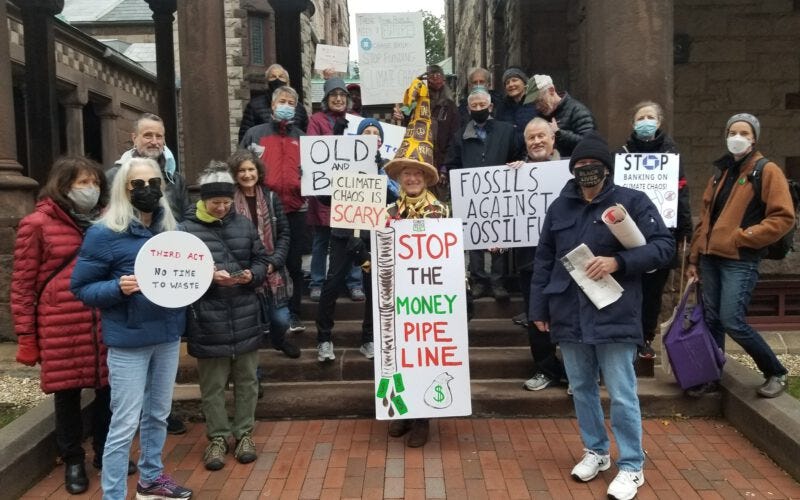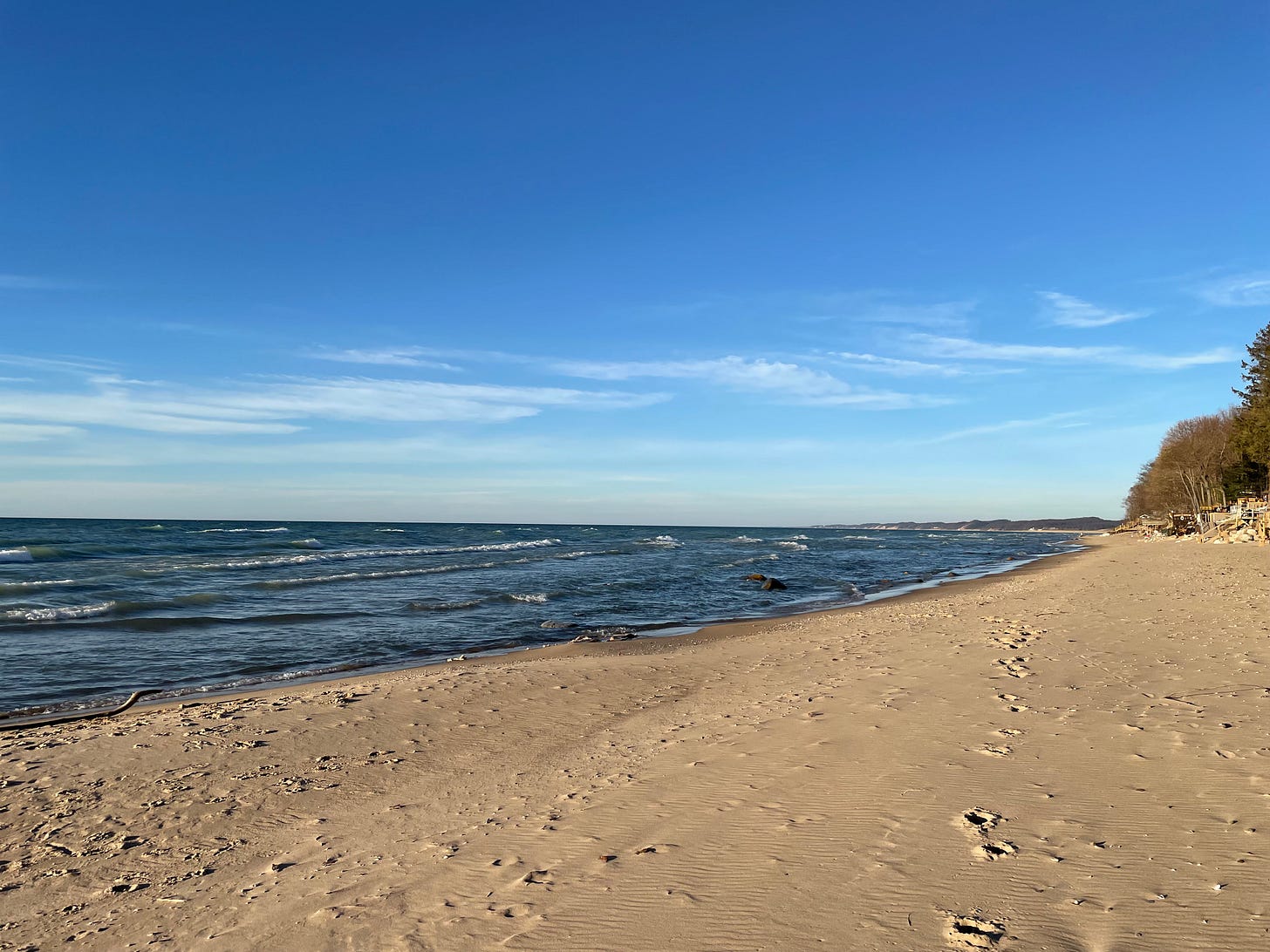Refugia Newsletter 33
Great Lakes resilience, biodiversity ambitions, stream clean-up, and scheming creatures
Refugia News
A special welcome to new subscribers this week—thanks for joining us!
Some of you are here, I know, thanks to the Evangelical Environmental Network Summit 2023 on January 19. As I’ve mentioned before, the good folks at EEN are working hard to demonstrate that evangelical Christians should and do care about climate—and can make a direct difference on policy. I enjoyed doing the (online) keynote talk for the Summit and “meeting” some folks in a breakout session afterwards. My keynote was about resilience, but it was basically “Refugia Faith in 20 minutes!” You can view the recording here.
(Image credit: thirdact.org)
This week I also attended the Third Act Faith meeting (also online—such is life now) as Third Act prepares for a major day of action as part of their Stop Dirty Banks campaign. Third Act is partnering with a host of other activist groups to pressure the Big Bad Banks (Wells Fargo, Citibank, Chase, and Bank of America) to stop funding any new fossil fuel projects.
Interested? Find out more at the Third Act website. Watch for news about this widespread campaign in the next few months. Divestment is crucial, but so is “stopping the money pipeline” to the fossil fuel industry’s continued pursuit of new projects when we should be focusing on rapid transition.
This Week in Climate News
This weeks’ theme: glamor-less process is important, or, boring meetings and boring documents matter.
I’ll illustrate with an example from my home region: the Great Lakes. I’ve been very well-behaved in this newsletter by not writing constantly about Michigan, but this week I’ll make an exception. Thanks to reader Karen Obits, I learned this week about the new Action Plan for a Resilient Great Lakes Basin.
This 14-page document is one of those non-binding vision documents crafted by a number of “stakeholders” from around the Great Lakes basin. The stakeholders come together as the Great Lakes Commission, founded back in 1955 in the recognition that ecosystems don’t care much about state or national boundaries—and that looking after the Great Lakes is a sober responsibility and should be shared. These days, the commission includes representation from eight US states and two Canadian provinces. Here’s a Michigan radio feature summarizing the story.
What’s the big deal with the report? Well, here’s how I see it: the report represents a growing recognition that we can’t manage climate change well as a bunch of uncoordinated private and public entities, all jostling with each other for what we want. In other words, it’s a recognition that competitive individualism requires rules set with care for the common good.
Here’s a quote from the report’s conclusion:
Building a resilient and adaptive Great Lakes basin will be a long-term endeavor that requires thoughtful coordination and inclusive dialogue with all members of the Great Lakes community. Regularly convening members, setting common goals, developing metrics to assess progress toward those goals, and using data to adapt our approaches to meet current and emerging needs will ensure efforts support the resilience, adaptive capacity health and vitality of the people, places, environment, and sustainable economy of the Great Lakes basin for current and future generations.
You can read the whole document here. It’s mostly a call to share information, protect vulnerable interests, and hold each other accountable. Is it a scintillating piece of prose? Not really. And I’m sure the process of arriving at the final version involved many long, sometimes boring meetings. But the process is the point, in a way: inviting an inclusive group of stakeholders together, setting mutually beneficial goals, and creating a document like this all help serve to build the infrastructure of common good.
(Fortunately, I have more photos of the Michigan lakeshore than you can shake a piece of driftwood at.)
We’ll stick with the Michigan angle for a quick update on the whole gas stove kerfuffle. Here’s a nice piece by Kelly House in Bridge Michigan on the gas stove battle lines in Michigan politics. The guy who introduced the federal ban-on-bans bill is the US Rep from Zeeland, Michigan, and a state rep has proposed a Michigan version of the bill. Meanwhile, we have a Democratic governor and Democratic-majority legislature. So even though 21 other states have passed ban-on-ban bills (as of Jan. 20), Michigan is not going there.
Who knew that gas stoves would become a (one hopes temporary) rallying cry of woke resistance? Never mind the data on links between gas stoves and childhood asthma that sparked (sorry) all this. Hard not to sprain one’s eyeballs, rolling them so hard when people declare they’ll go down fighting over their stoves. For fun, just Google “gas stove memes.” You’re welcome.
I actually do have a gas stove. When we moved into this house in 2010, I spent an eye-popping 500 bucks just to have the gas line installed! Doggone it. Wish I knew then what I know now. Well, we have been planning to replace it with an induction stove, though not for about two years. First comes native plants in the front yard and then a heat pump.
Deeper Dive
Back to the topic of boring documents and meetings. I’ve been wanting to acknowledge the UN Convention on Biodiversity agreement adopted in December in Montreal at “COP15.” Oddly enough, the agreement is another 14-page document. It’s especially remarkable for its emphasis on justice issues, indigenous leadership, and rights of nature language.
Katie Surma of Inside Climate News wrote a succinct and thorough article explaining the agreement and its importance. Here’s a quick summary:
In the agreement, 196 governments laid out 23 biodiversity targets to be met by 2030, including a top-line goal to protect 30 percent of the world’s land and oceans. Governments also promised to mobilize at least $200 billion in public and private funding for biodiversity protection by 2030, including $30 billion paid from developed countries to developing countries.
Similarly to the Great Lakes Resilience Plan, all this is non-binding—though of course, much more in the global public eye. Once again, though, the process is significant in itself. One of the most important developments with the Montreal process was the inclusion of indigenous stakeholders, important in the effort to avoid the kind of “fortress conservation” that has ended up disrespecting the rights of indigenous people. Surma writes:
language in the agreement is aimed at pushing governments toward an approach to conservation that harnesses the knowledge and participation of Indigenous and local communities while respecting their rights.
Although 196 governments signed on to the document, the US remained an “observer state.” Meanwhile, the European Parliament is already working on an ambitious biodiversity restoration law that, if passed this summer, will follow up on the UN agreement goals.
(Credit: Andrej Ivanov/ AFP via Getty Images via Inside Climate News)
Refugia Sighting
I can’t believe that in over a year of these newsletters, I’ve never featured Plaster Creek Stewards! PCS are a “collaboration of Calvin University faculty, staff, and students working with local partners to restore Plaster Creek watershed,” the watershed in which Calvin University is located. Plaster Creek flows into the Grand River, which flows into Lake Michigan. And thanks to years of industrial pollutants and many other kinds of run-off, Plaster Creek was one of the most polluted waterways in Michigan by the early 2000s.
My good colleagues at Calvin University started this project in 2004, and they have been faithful refugia-creators ever since, gathering many hundreds of students and community partners over the years in their healing work. PCS focuses on education, research, and practical restoration in the watershed. They’ve been very important to me in my own journey toward becoming a “person of refugia.”
Plaster Creek Stewards illustrate beautifully how striving to create literal refugia in the local ecosystems can also create refugia spaces in human terms, by bringing people together in community to “love their downstream neighbors.”
(I was actually there on this work day, muddy knees and all. Image credit: Dave Warners.)
The Wayback Machine
What if animals had boring meetings, too? Or maybe rather amusing ones? I wrote this piece back April of 2020 when we were hearing news stories about animals venturing back into human-dominated spaces because we were all hiding inside in Covid quarantine. I wondered: do you suppose the animals are scheming together, trying to get our attention about something?









Love what this letter’s doing with such verve and thoroughness!